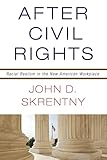After Civil Rights : Racial Realism in the New American Workplace / John D. Skrentny.
Material type: TextPublisher: Princeton, NJ : Princeton University Press, [2013]Copyright date: ©2013Edition: Course BookDescription: 1 online resource (416 p.) : 1 halftone. 8 line illusContent type:
TextPublisher: Princeton, NJ : Princeton University Press, [2013]Copyright date: ©2013Edition: Course BookDescription: 1 online resource (416 p.) : 1 halftone. 8 line illusContent type: - 9780691159966
- 9781400848492
- Civil rights -- United States
- Civil service -- United States
- Discrimination in employment -- United States
- Race discrimination -- United States
- SOCIAL SCIENCE / Discrimination & Race Relations
- American values
- American workplace
- Asian workers
- First Amendment
- Latino workers
- advertising
- civil rights law
- civil rights
- classical liberalism
- education
- employee
- employers
- employment qualifications
- entertainment
- film industry
- government employment
- government
- immigrant realism
- law enforcement
- low-skilled employment
- mass immigration
- meatpacking
- medicine
- political elites
- politicians
- politics
- professional employment
- professional sports
- race
- racial abilities
- racial difference
- racial differences
- racial discrimination
- racial diversity
- racial hierarchy
- racial realism
- racial signaling
- racial-realist management
- television shows
- white-collar
- workplace dynamism
- 331.1330973 23
- HD4903.5.U58 S5697 2017
- online - DeGruyter
- Issued also in print.
| Item type | Current library | Call number | URL | Status | Notes | Barcode | |
|---|---|---|---|---|---|---|---|
 eBook
eBook
|
Biblioteca "Angelicum" Pont. Univ. S.Tommaso d'Aquino Nuvola online | online - DeGruyter (Browse shelf(Opens below)) | Online access | Not for loan (Accesso limitato) | Accesso per gli utenti autorizzati / Access for authorized users | (dgr)9781400848492 |
Frontmatter -- Contents -- List of Figures and Tables -- Preface -- Chapter 1. Managing Race in the American Workplace -- Chapter 2. Leverage -- Chapter 3. We the People -- Chapter 4. Displaying Race for Dollars -- Chapter 5. The Jungle Revisited? -- Chapter 6. Bringing Practice, Law, and Values Together -- Notes -- Index
restricted access online access with authorization star
http://purl.org/coar/access_right/c_16ec
What role should racial difference play in the American workplace? As a nation, we rely on civil rights law to address this question, and the monumental Civil Rights Act of 1964 seemingly answered it: race must not be a factor in workplace decisions. In After Civil Rights, John Skrentny contends that after decades of mass immigration, many employers, Democratic and Republican political leaders, and advocates have adopted a new strategy to manage race and work. Race is now relevant not only in negative cases of discrimination, but in more positive ways as well. In today's workplace, employers routinely practice "racial realism," where they view race as real--as a job qualification. Many believe employee racial differences, and sometimes immigrant status, correspond to unique abilities or evoke desirable reactions from clients or citizens. They also see racial diversity as a way to increase workplace dynamism. The problem is that when employers see race as useful for organizational effectiveness, they are often in violation of civil rights law. After Civil Rights examines this emerging strategy in a wide range of employment situations, including the low-skilled sector, professional and white-collar jobs, and entertainment and media. In this important book, Skrentny urges us to acknowledge the racial realism already occurring, and lays out a series of reforms that, if enacted, would bring the law and lived experience more in line, yet still remain respectful of the need to protect the civil rights of all workers.
Issued also in print.
Mode of access: Internet via World Wide Web.
In English.
Description based on online resource; title from PDF title page (publisher's Web site, viewed 30. Aug 2021)


